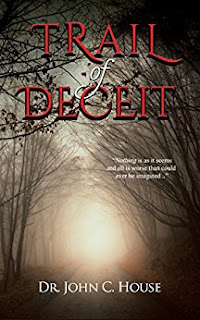John House is the author of the new novel Uncommon Bond, which focuses on a U.S. Army doctor who becomes a POW during the Vietnam War. He also has written Rancor and Trail of Deceit.
He served in the U.S. Army in Vietnam, and has practiced family
medicine for 50 years. He lives on the southeast coast of Georgia.
Q: How did you come up with the idea for Uncommon Bond, and for your main characters?
A: The idea came from my knowledge of a flight surgeon in the 1st
Cavalry Division who became a POW when the helicopter in which he was a
passenger went down in South Vietnam.
He was captured by the Viet Cong before U.S. forces arrived. He was
initially held by the VC and later transferred to the North Vietnamese
who moved him north to Hanoi. That is the only part of the story that is
factual history; the rest came from my imagination.
The character David Hanson, the American flight surgeon, was based on
a composite of physicians, including me. I utilized my knowledge of the
years of training in medical school, internship, and residency. Then
came the draft, the indoctrination in the U.S. Army at Fort Sam Houston,
Texas, and, for some, attendance at the aviation medicine school at
Fort Rucker, Alabama.
I attended North Georgia College, the Senior Military College in
Georgia, and was commissioned as second lieutenant upon graduation. After
medical school and internship, I entered the U.S. Army and volunteered
for Vietnam. Many physicians were drafted and were bitter over the
interruption of their medical training.
I developed the character Major Duc Phan Thiet from my imagination. I
used the name of my South Vietnamese interpreter who accompanied me on
visits to the many villages around our base camp to provide medical
care. It wasn’t hard to imagine that the medical people of the NVA
worked under primitive conditions and great stress.
Q: What did you see as the right blend between the historical and fictional aspects of the story?
A: The historical facts involved: the Vietnam War, the presence of
the 1st Cavalry Division, the actual units involved in the story, and,
other than name changes, the characters are composites of many men who
fought bravely in that war. I was the flight surgeon for 2/20th Aerial
Rocket Artillery battalion, Cobra gunships, located in Phuoc Vinh, Tay
Ninh, and Quan Loi.
The fictional aspect involved the relationship between Dr. Hanson and
Major Duc. I wanted to show the brutality of war and the human
relationships that can develop when former enemies learn they are
similar in many ways.
Q: What do you hope readers take away from the book?
A: All members of the NVA weren’t monsters, just like all members of
the U.S. Army weren’t saints. What I depicted in this story has happened
in all wars when former combatants learn they have much in common. They
all have loved ones they left at home, and hope to return to someday.
David Hanson, the American flight surgeon, suffered torture with
physical and mental abuse until he met Major Duc Phan Thiet, the NVA
surgeon. Then he discovered a greater pain, an emotional pain, when he
refused to violate his oath of office and help the overworked surgeon
care for the NVA and VC wounded.
When circumstances forced him to choose between his oath to his
country and his Hippocratic Oath, the guilt he experienced from his
choice was soothed by his relationship with Major Duc’s wife, a civilian
nurse who had traveled over the Ho Chi Minh Trail from Hanoi through
Laos and Cambodia to be with her husband.
Q: Who are some of your favorite authors?
A: My favorite author in my youth was Alistair MacLean, the author of The Guns of Navarone
and many other titles. I have managed to collect all his works. Later
in life, I’ve enjoyed James Patterson, Lee Childs, Stuart Woods, and
Charles Martin. One of my favorite writers of historical fiction is
David L. Robbins.
Q: What are you working on now?
A: Presently I’m working on three different manuscripts with most of
my time spent on a story involving a Catholic priest and a prostitute
brought together by fate when they both chose the same place and time on
the Golden Gate Bridge to jump to their deaths.
Q: Anything else we should know?
A: I’m in my 50th year of practicing family medicine and I work in a
clinic 4½ days a week. Despite my busy schedule, I always find time to
write.
--Interview with Deborah Kalb. This interview also appears on hauntinglegacy.com.




No comments:
Post a Comment